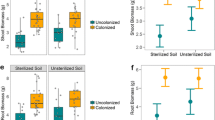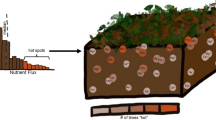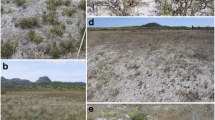Abstract
Recently, it was hypothesized that ectomycorrhizas hyphae are involved in mineral tunneling. We evaluated the role of ectomycorrhizas in mineral weathering and the ecosystem influx of basic cations by correlating mineral tunnel density to ectomycorrhizas density in two forest productivity gradients. The gradients, two gentle slopes in northern Sweden, are the result of groundwater movement and are characterized by reduced productivity upslope due to lower nitrogen availability. As expected, ectomycorrhizas density in the O horizon was higher upslope, where nitrogen availability was lower and where the vegetation was dominated by ectomycorrhizas plant species. We consistently found that tunnel formation in mineral grains was more intense in nutrient-poor sites, indicating a higher contribution of fungi to ecosystem influx of potassium and calcium. ectomycorrhizas density was positively correlated with feldspar tunnel density in the upper 2 cm of the E horizon. This suggests that ectomycorrhizas are involved in mineral tunneling. We discuss the possible involvement of ericoid mycorrhizas and saprotrophic fungi in feldspar tunneling and the role of the weathering status of mineral grains as additional factors controlling mineral funneling.

Similar content being viewed by others
References
MF Allen C Figueroa BS Weinbaum SB Barlow EB Allen (1996) ArticleTitleDifferential production of oxalate by mycorrhizal fungi in arid ecosystems. Biol Fertil Soils 12 287–92
E Bååth B Söderström (1982) ArticleTitleSeasonal and spatial variation in fungal biomass in a forest soil. Soil Biol Biochem 14 353–8
AE Blum LL Stillings (1995) Feldspar dissolution kinetics. AF White SL Brantley (Eds) Chemical weathering rates of silicate minerals Mineralogical Society of America Washington (DC) 291–351
P Bullock N Fedoroff A Jongerius G Stoops T Tursina (1985) Handbook for soil thin section description Waine Research Wolverhampton 152
JR Cumming TD Swiger BS Kurnik DG Panaccione (2001) ArticleTitleOrganic acid exudation by Laccaria bicolor and Pisolithus tinctorius exposed to aluminum in vitro. Can J For Res 31 703–10
MV Dutton CS Evans (1996) ArticleTitleOxalate production by fungi: its role in pathogenicity and ecology in the soil environment. Can J Microbiol 42 881–95
EA FitzPatrick (1970) A technique for the preparation of large thin sections of soils and consolidated material. DA Osmond P Bullock (Eds) Micromorphological techniques and applications Soil Survey of England and Wales Harpenden (UK) 3–13
GM Gadd (1999) ArticleTitleFungal production of citric and oxalic acid: importance in metal speciation, physiology and biogeochemical processes. Adv Microb Physiol 41 47–92
R Giesler M Högberg P Högberg (1998) ArticleTitleSoil chemistry and plants in Fennoscandian boreal forest as exemplified by a local gradient. Ecology 79 119–37
R Giesler T Petersson P Högberg (2002) ArticleTitlePhosphorus limitation in boreal forests: effects of Al and Fe accumulation in the humus layer. Ecosystems 5 300–14
E Hoffland R Giesler T Jongmans N Van Breemen (2002) ArticleTitleIncreasing feldspar tunneling by fungi across a north Sweden podzol chronosequence. Ecosystems 5 11–22
E Hoffland R Landeweert TW Kuyper N van Breemen (2001) ArticleTitle(Further) links from rocks to plants. Trends Ecol Evol 16 544
P Högberg (2001) Interactions between hillslope hydrochemistry, nitrogen dynamics and plants in Fennoscandian boreal forests. ED Schulze SP Harrison M Heimann EA Holland J Lloyd IC Prentice DS Schimel (Eds) Global biogeochemical cycles in the climate system Academic Press San Diego (CA) 227–33
AG Jongmans N Van Breemen US Lundström PAW Van Hees RD Finlay M Srinivasan T Unestam R Giesler P-A Melkerud M Olsson (1997) ArticleTitleRock-eating fungi. Nature 389 682–3
R Landeweert E Hoffland RD Finlay TW Kuyper N Van Breemen (2001) ArticleTitleLinking plants to rocks: ectomycorrhizas fungi mobilize nutrients from minerals. Trends Ecol Evol 16 248–54
R Landeweert C Veenman TW Kuyper H Fritze K Wernars E Smit (2003a) ArticleTitleQuantification of ectomycorrhizal mycelium in soil by real-time PCR compared to conventional quantification techniques. FEMS Microbial. Ecol. 45 283–292
R Landeweert P Leeflang TW Kuyper E Hoffland A Rosling K Wernars E Smit (2003b) ArticleTitleMolecular identification of ectomycorrhizal mycelium in soil horizons. Appl. Environ Microbial. 69 327–333
C Leyval J Berthelin (1993) ArticleTitleRhizodeposition and net release of soluble organic compounds by pine and beech seedling inoculated with rhizobacteria and ectomycorrhizas fungi. Biol Fertil Soils 15 259–67
EI Newman (1966) ArticleTitleA method of estimating the total lentgh of roots in a sample. J Appl Ecol 3 139–45
NilssonL, O, Wallander,H, Bååth, E. 2001. N fertilization results in reduced growth of ectomycorrhizas (EM) mycelium in the field. Proceedings of the Third International Conference on Mycorrhiza (ICOM3), Adelaide, Australia. p P2–22.
A Nordin P Hogberg T Nasholm (2001) ArticleTitleSoil nitrogen from and plant nitrogen uptake along a boreal forest productivity gradient. Oecologia 129 125–32
PA Olsson H Wallander (1998) ArticleTitleInteractions between ectomycorrhizas fungi and the bacterial community in soils amended with various primary minerals. FEMS Microbiol Ecol 27 195–205
B Söderström (1979) ArticleTitleSeasonal fluctuations of active fungal biomass in horizons of a podzolized pine-forest soil in central Sweden. Soil Biol Biochem 11 149–54
InstitutionalAuthorNameSoil Survey Staff (1998) Keys to soil taxonomy US Department of Agriculture Washington (DC) 325
RM Thompson CR Townsend D Craw R Frew R Riley (2001) ArticleTitle(Further) links from rocks to plants. Trends Ecol Evol 16 543
N Van Breemen RD Finlay US Lundström AG Jongmans R Giesler P-A Melkerud (2000a) ArticleTitleMycorrhizal weathering: a true case of mineral plant nutrition? Biogeochemistry 49 53–67
N Van Breemen US Lundstrom AG Jongmans (2000b) ArticleTitleDo plants drive podzolization via rock-eating mycorrhizal fungi? Geoderma 94 163–71
JDJ Van Doesburg (1996) Particle-size analysis and mineralogical analysis. P Buurman B Van Lagen EJ Velthorst (Eds) Manual for soil and water analysis Backhuys Leiden (Netherlands) 251–78
H Wallander (2000a) ArticleTitleUptake of P from apatite by Pinus sylvestris seedlings colonised by different ectomycorrhizas fungi. Plant Soil 218 249–56
H Wallander (2000b) ArticleTitleUse of strontium isotopes and foliar K content to estimate weathering of biotite induced by pine seedlings colonised by ectomycorrhizas fungi from two different soils. Plant Soil 222 215–29
H Wallander LO Nilsson D Hagerberg E Baath (2001) ArticleTitleEstimation of the biomass and seasonal growth of external mycelium of ectomycorrhizas fungi in the field. New Phytol 151 753–60
H Wallander T Wickman (1999) ArticleTitleBiotite and microcline as potassium sources in ectomycorrhizas and non-mycorrhizas Pinus sylvestris seedlings. Mycorrhiza 9 25–32
Acknowledgements
We are grateful to Lars Ola Nilsson and Dr. Håkan Wallander (Department of Microbial Ecology, Lund University, Sweden) for sharing unpublished results. Willeke van Tintelen, Jan van Doesburg, and Arie van Dijk provided expert technical assistance. E.H. received financial support from the Netherlands Organization for Scientific Research (NWO). R.G. was supported in part by the Carl Trygger Foundation.
Author information
Authors and Affiliations
Corresponding author
Rights and permissions
About this article
Cite this article
Hoffland, E., Giesler, R., Jongmans, A. et al. Feldspar Tunneling by Fungi along Natural Productivity Gradients . Ecosystems 6, 739–746 (2003). https://doi.org/10.1007/s10021-003-0191-3
Received:
Accepted:
Published:
Issue Date:
DOI: https://doi.org/10.1007/s10021-003-0191-3




